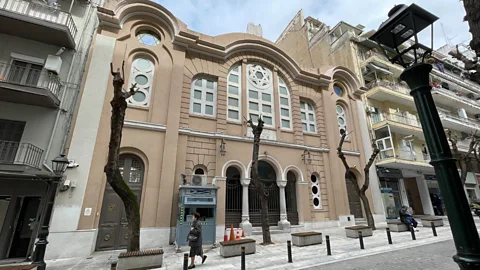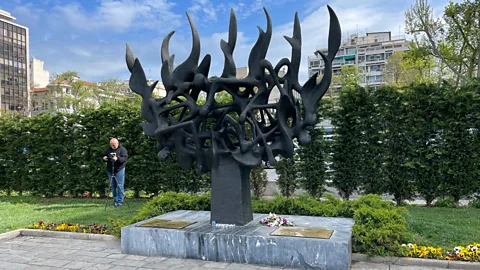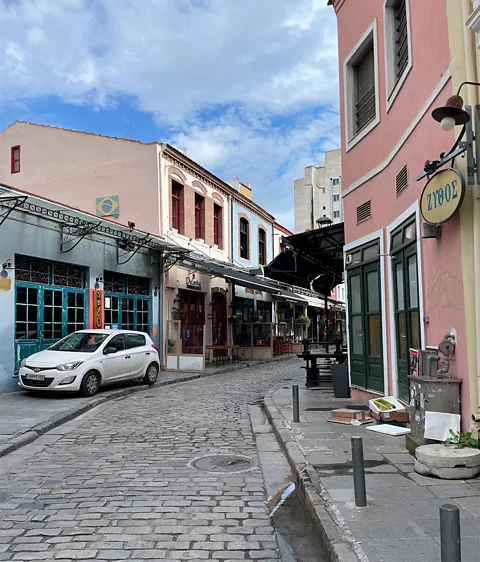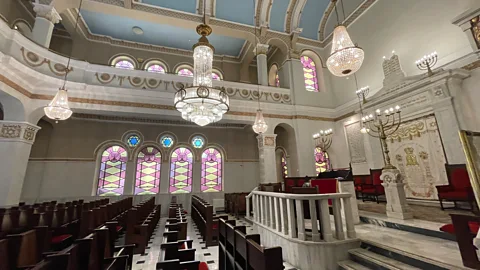In search of Greece's once-great Jewish city
 Naomi Tomky
Naomi TomkyOnce home to a thriving Jewish majority, Thessaloniki holds fragments of a lost world. One traveller's journey to find them leads to something even more powerful: living memory.
As my family admired the gleaming remodel of Thessaloniki's century-old Modiano Market, local culinary guide Smaragda Marki admitted to me that among the trendy cafes and German delicatessen, she wished it were just a little more Greek. "I wish it were a little more Jewish," I responded, staring up at the colourful Easter decorations.
The newly reopened market had topped my list of places to go in Greece's second-largest city, bringing together my two favourite things to look for while travelling: good food and tidbits of Jewish history. However, Modiano left me dissatisfied on both counts. Though the building still bears the name of its Jewish architect and stands on the site of the former Talmud Torah Synagogue, little else hinted that the nut stand used to be a kosher butcher or that Jews had any other part of its past life.
Thessaloniki was once considered an epicentre of Jewish culture, one of the only cities in Europe where Jews were the majority. Known as Salonika at the time, it was part of the Ottoman Empire until 1912. The Ottoman Empire allowed Jews escaping the Spanish Inquisition in the 15th Century to settle there for hundreds of years. But with Ottoman power beginning to wane in the early 20th Century, Greece took over the city in 1912. Five years later, the Great Fire of 1917 devastated huge swaths of the city and left 70,000 people homeless, including much of the Jewish population. The Talmud Torah Synagogue (and 31 others) were destroyed. The one-time centre of Jewish culture and majority Jewish city received its final blow in 1943 when Nazi forces deported 50,000 Jews to Europe's concentration camps.
 Naomi Tomky
Naomi TomkyEighty years later, I struggled to find traces of the community, and even finding a Jewish guide to show me around proved difficult. It wasn't surprising; Thessaloniki's Jewish community now numbers less than 1,000 people, a small population sample within which to find a niche professional tour guide. Plenty of companies offered tours of Jewish Thessaloniki, most touting bonafides by proximity to, rather than being a part of the small congregation.
Eventually, I booked through a company based in Athens because it was run by a Greek Jew. I still didn't know if my actual guides would be Jewish, though at least I could be sure they were trusted by the community.
When Elia Matalon greeted us the next morning, I let out a sigh of relief. In the lobby of our hotel, he explained that he and his wife Hella Kounio-Matalon run their tours together and they both come from families that go back many generations in Thessaloniki's Jewish community. Later in the eight-hour tour he would tell us about how his mother survived the war by hiding in homes across the border in Albania while Kounio-Matalon spoke of her father surviving Auschwitz. We began walking toward a Holocaust memorial sculpture, through a narrow alleyway where he pointed to a restaurant owned by a gentile chef who became fascinated by the city's Jewish history and now serves traditional Sephardic Jewish foods like nogada (meatballs in walnut sauce).
Much of the city's history is Jewish history. In the Ano Ladadika neighbourhood, we stared up at the city's famous broken clock, stopped by an earthquake in 1978. The building originally belonged to a bank started by the Italian Jewish Allatini brothers, 19th-Century entrepreneurs whose flour company grew to be the largest in the Balkans before World War Two.
 Naomi Tomky
Naomi TomkyWe walked down adjacent Siggrou Street and paused in front of a 1926 mansion. Today, it houses a hookah bar, which meant we could wander into the lovely plant-filled atrium and up the grand staircase. Outside, Matalon pointed out the holes in the doorpost where a mezuzah once hung. A visible symbol of Jewish identity, the traditional decorative case holds a prayer, fulfilling the commandment to "write them on the doorposts of your house".
So much of visiting Jewish history around the world is like this: evidence of where we once were. Visiting the former site of the Jewish cemetery. Peering at painted-over holes and fading stars of David. Jews left their mark on Thessaloniki, but hardly in a fashion that hints to the glorious centre of Jewish life it once was. I love to imagine what it was like to live in these rich Jewish worlds, what could be if we weren't constantly getting kicked out of places.
Across the street from Modiano Market, we entered one of the city's two remaining synagogues. Because Thessaloniki's laws granted properties owned by Jews before WW2 without surviving family members to the Jewish community, the congregation owns the building, which mostly houses offices, and the synagogue on the ground floor. Marble tablets on the wall list the more than 70 synagogues that served the city's once much-larger Jewish population. The money the rent brings in allows the synagogue to pay retirees to show up to complete their minyan (the minimum number of people needed for a prayer service), a win-win situation.
More like this:
• The Mediterranean's ancient gay-friendly civilisation
Outside the building, I learned how a bench signals that a piece of Thessaloniki's Jewish culture still lives within. The decorative wooden top looks the same as any other bench, a comforting and welcoming place to sit on busy Vasileos Irakleiou, between a synagogue and Modiano Market. Below, a sturdy cement bollard telegraphs its true purpose: these surround all the remaining Jewish sites in the city, protecting them from potential violence by vehicle.
 Naomi Tomky
Naomi TomkyWe see them again outside the only remaining pre-WW2 synagogue, the community's other house of prayer. The Monastir Synagogue escaped destruction by invading Axis forces because the Red Cross used it during the war, a story that would be slightly more heartwarming if they hadn't nearly destroyed it themselves by using it as a storehouse and stable. It has since been returned to its stained-glass and marble-walled glory.
A large tour group from a cruise, wearing headsets to hear their guide, filed in, and I browsed the tiny museum in the foyer until they left, just a few minutes later. Then Matalon and Kounio-Matalon announced that they had a surprise for us. Together, they offered to sing a song in Ladino, the ancient version of Judeo-Spanish spoken by the region's Jews: Adio Kerido (Goodbye, Beloved), a love song repurposed as a farewell to Holocaust deportees.
By the time they stepped onto the bimah, the raised platform at the front of the sanctuary, I had already seen the history for which I came: the train car parked permanently at the station in memory of the city's Jews, who were deported in similar ones; the mansions built by the thriving majority population of the 19th Century; and the lovely, solemn Jewish Museum of Thessaloniki. But as their voices joined, reverberating in the incredible acoustics of the large room, singing "Adio, adio, kerido", I realised I'd found something even better: a unique Jewish culture still alive.
"No kero la vida," they sang hauntingly, beautifully, mournfully, "I don't want to live." The song offered such sorrow for the departing love, but it brought me such happiness to hear, to see this moment, the kind of moment for which people travel. A moment that could never be predicted, that could never be expected, and, more than anything, that could never happen anywhere else in the world except precisely here.
--
If you liked this story, sign up for The Essential List newsletter – a handpicked selection of features, videos and can't-miss news, delivered to your inbox twice a week.
